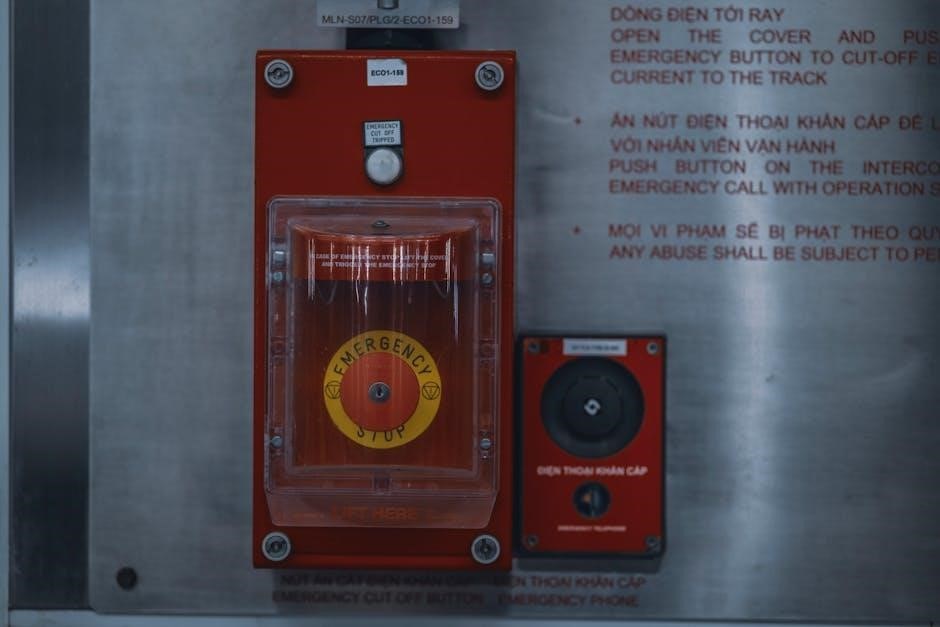Manual override refers to bypassing automated control functions, allowing direct hands-on control of devices or systems using traditional methods like physical buttons or switches within specific systems naturally.
Definition and Purpose
Manual override is a mechanism that allows users to take control of a device or system from an automated process, giving them the ability to make manual adjustments as needed. This feature is particularly useful in situations where automated systems fail or are not functioning as intended. The purpose of manual override is to provide a fallback option, enabling users to operate devices or systems manually, using traditional methods such as physical buttons or switches. This can be applied to various systems, including photography, where manual override allows photographers to turn off automatic features and take control of the camera settings. The definition of manual override emphasizes the importance of human intervention in automated processes, allowing for more flexibility and control. By understanding the definition and purpose of manual override, users can better appreciate its significance in various applications and industries. Manual override is a crucial feature that ensures systems can be operated safely and efficiently.

Types of Manual Override
Manual override types include mechanical, electrical, and software-based systems naturally.
Real-World Examples
Manual override is used in various real-world applications, including photography, where it allows photographers to bypass automatic settings and take control of the camera. This feature is particularly useful in situations where the automatic settings are not producing the desired results. In addition, manual override is used in building automation systems, where it enables users to override automated controls and take manual control of devices such as lighting and ventilation systems. Manual override timer switches are also used to manually activate ventilation systems in buildings. Furthermore, manual override is used in credit rating systems, where it allows human interveners to override automated decisions and amend credit scores. These examples demonstrate the importance of manual override in various industries and applications, and highlight its ability to provide users with more control and flexibility. Overall, manual override is a useful feature that can be applied in a wide range of contexts.

Importance of Manual Override
Manual override provides users with control and flexibility, allowing intervention in automated systems for improved outcomes and efficiency naturally every time always.
Applications of Manual Override
Manual override has various applications in different fields, including photography, where it allows photographers to override automatic settings for better control. In smart home systems, manual override enables users to operate devices physically, even when automated features are not available. Additionally, manual override is used in industrial automation, where it provides a means to intervene in automated processes for maintenance, repair, or quality control purposes. This feature is also essential in medical devices, such as ventilators, where manual override can be crucial in emergency situations. Furthermore, manual override is applied in transportation systems, including aircraft and vehicles, to ensure safe operation and prevent accidents. The use of manual override in these applications enhances safety, efficiency, and productivity, making it a vital component of modern technology. Overall, manual override plays a significant role in ensuring the reliable operation of complex systems and devices. It provides a necessary backup and allows users to take control when needed.

Limitations of Manual Override
Manual override has limitations, including increased risk of human error and potential system instability when automated controls are bypassed suddenly and incorrectly within complex systems naturally.
Examples of Override-Related Failures
There are several examples of override-related failures that have been documented in various industries. For instance, in the context of photography, a manual override failure can result in poorly exposed images. Similarly, in industrial control systems, a manual override failure can lead to equipment damage or even safety risks. In credit rating systems, override-related failures can result in inaccurate credit scores, leading to financial losses for individuals or organizations. These examples illustrate the importance of careful consideration and implementation of manual override mechanisms to minimize the risk of failures. Furthermore, override-related failures can also occur in building automation systems, where a manual override failure can disrupt heating and cooling systems, leading to uncomfortable working conditions. These failures can be costly and time-consuming to repair, highlighting the need for robust manual override systems. Effective design and testing of manual override mechanisms are essential to prevent such failures.
Manual override provides essential control and flexibility in various systems naturally and effectively always.
Future Developments

As technology advances, manual override systems are likely to become more sophisticated and integrated into various devices and systems. The development of new materials and technologies will enable the creation of more efficient and reliable manual override mechanisms. Additionally, the increasing use of automation and artificial intelligence in various industries will require more advanced manual override systems to ensure safe and efficient operation; Furthermore, the growth of the Internet of Things (IoT) will lead to the development of more connected and intelligent manual override systems. These systems will be able to communicate with other devices and systems, providing real-time monitoring and control. Overall, the future of manual override systems looks promising, with ongoing research and development aimed at improving their performance, reliability, and functionality. New innovations and technologies will continue to emerge, shaping the future of manual override systems and their applications.